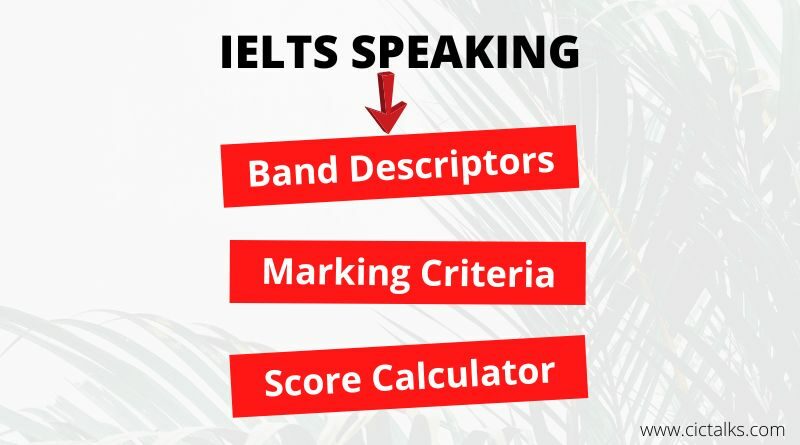IELTS Speaking: Band descriptors and Score calculation
In this post, you’ll find IELTS Speaking Band descriptors, Score chart, Score calculator and Marking sheet.
IELTS Speaking test assesses applicants’ ability to communicate in the English language. Speaking part of the test involves face-to-face interaction between the candidate and the examiner. To do better in this module, applicants must first comprehend the format and various factors that make the basis of band 7 or higher band score.
Let’s dive into how the IELTS Speaking score is calculated and what band descriptor criteria do the examiners use while marking on the score sheet.
IELTS Speaking Band Descriptors
The 4 types of IELTS Speaking Band Descriptors used by IDP & British Council are explained below:
1. Fluency and Coherence (FC)
This band descriptor in IELTS Speaking tests whether your speech is fluent and structured or not. There are some ways to increase your fluency and coherence:
- Use linking words and signposts to connect your phrases.
- Extend your responses and include all essential information.
- Use proper pausing to speak fluently and continuously.
2. Lexical Resource (LR)
Lexical Resource is used to measure the candidates’ range of vocabulary. To increase band scores in LR descriptor:
- Make use of colloquial expressions and idiomatic language.
- Use mixed vocabulary i.e formal, informal and semi-formal.
- Use less frequent vocabulary.
3. Grammatical Range and Accuracy (GRA)
This band descriptor assess candidates’ ability to use varied grammatical structures and their accuracy. Follow these tips to improve GRA:
- Use well-structured sentences.
- Try to speak advance grammatical structures including conditional tenses, passive voice etc.
- Make sure that your grammar is accurate.
4. Pronunciation (P)
To assess how natural the speech is, pronunciation descriptors are used. To improve pronunciation:
- Use accurate intonations.
- Make sure that your pronunciation is clear.
- Use a recorder to record your speech and identify mistakes.
- Don’t speak too fast.
Download IELTS Speaking Band descriptors PDF from the official IELTS site.
IELTS Speaking Score Chart
IELTS Speaking band score ranges from 0-9:
- Zero (0) is the lowest score in the Speaking test which is awarded to a student who did not attend the test.
- Six (6) is the average score in the Speaking test which is awarded to a student with standard English proficiency.
- Nine (9) is the highest score in the Speaking test which is awarded to a student with advanced vocabulary and language skills.
To understand the Speaking score division further, look at the chart below:
| IELTS Speaking Score | FC | LR | GRA | P |
|---|---|---|---|---|
| Band score 9 | Speaks in a logical manner with all of the necessary cohesion qualities. Topics are thoroughly developed and relevant. Speaks smoothly with barely a few instances of self-correction or repetition. Any uncertainty stems from the topic rather than a lack of vocabulary or language. | Uses vocabulary with complete flexibility and precision. Idiomatic language is used in a natural and accurate manner. | Apply a wide variety of structures in a natural and acceptable manner. Apart from some errors; produces dependably accurate structures. | Employs a broad range of pronunciation qualities. Ensures that intonation is used in a flexible manner throughout the speech. |
| Band score 8 | Fluently communicates with just minor repetition or self-correction. Hesitation is mainly caused by a lack of understanding of the content, and only very rarely by a lack of understanding of the language. Develops speech in a logical and acceptable manner. | Convey the exact meaning quickly using wide vocabulary. Uses less common and colloquial words. Sometimes use paraphrasing as well. | Uses a variety of grammatical structures in a flexible manner. Produces a large number of correct sentences, with only a few errors. | Clearly demonstrates a wide range of pronunciation. Maintains a flexible tone with only minor errors. Speech is simple to follow throughout. |
| Band score 7 | Employs a variety of connectives and discourse markers with some flexibility to speak at length without evident effort. Show language-related hesitancy or some repetition at times. | Use of topic specific vocabulary, including some less common and idiomatic language. Displays some understanding of style and collocation. | Frequently creates error-free structures. However, some grammatical errors are observed. | Shows all of Band 6 speaking features, as well as some Band 8 speech features. |
| Band score 6 | Willing to speak at length, however occasionally loses coherence owing to repetition, self-correction, or hesitancy. Employs a variety of connectives and discourse markers, though not always correctly. | Has a wide set of vocabulary to explain topics in depth despite inaccuracies. Often paraphrases well. | Uses a mixture of simple and complicated tense structures, but speech suffers from frequent errors. | Employs a wide variety of pronunciation features but not sustained. Mispronunciation of specific words or sounds occur at times. |
| Band score 5 | May over-use particular connectives and discourse markers smoothly. Provides simple conversation, while more complicated communication causes fluency problems. | Tries to use paraphrasing but makes lot of errors. Manages to communicate about both familiar and unexpected themes with little vocabulary flexibility. | Generates basic sentence structures. Uses some complicated structures, although these are often riddled with errors. | Shows all the positive speaking features of Band 4, as well as some Band 6 speech features. |
| Band score 4 | Has significant pauses and may talk slowly. Has frequent repetition of words. Some coherence breakdowns are observed as well. | Can talk about familiar topics but with limitations. Makes frequent grammatical errors. | Shows basic sentence forms and some simple sentence corrections. But faults in subordinate structures are common and might lead to confusion. | Has a limited set of pronunciation features. Mispronunciations generally cause some difficulties for the listener. |
| Band score 3 | Has a poor capacity to combine simple words. Only delivers short responses. Speaks with significant pauses. | Has insufficient vocabulary for less common topics. Utilises basic vocabulary to convey personal knowledge. | Fails to use basic sentence structures. Depends only on memorised phrases. Makes frequent mistakes. | It demonstrates some of the features of Band 2, as well as some of the features of Band 4. |
| Band score 2 | Most words are preceded by long gaps. Little communication is possible. | Only produces memorised phrases. | Unable to produce basic sentence patterns. | Speech is frequently difficult to understand. |
| Band score 1 | There is no way to communicate. Unable to rate language usage. | There is no way to communicate. Unable to rate language usage. | There is no way to communicate. Unable to rate language usage. | There is no way to communicate. Unable to rate language usage. |
| Band score 0 | Candidate was absent |
How is the IELTS speaking score calculated?
The four descriptors of the IELTS speaking exam determine how well you talk. A test candidate receives a band score ranging from 0 to 9 based on the above-mentioned score chart. Then the arithmetic mean is applied to determine the final Speaking score.
To give you an idea of the IELTS speaking score calculation, look at the table below:
| Marking Criteria | Band Score |
|---|---|
| Fluency and Coherence | 8.0 |
| Lexical Resource | 7.0 |
| Grammatical range and accuracy | 7.0 |
| Pronunciation | 6.0 |
| Final IELTS Speaking score = (8+7+7+6)/4 | 7.0 |
Therefore, if your scores are: FC – 8.0, P – 6.0, LR – 7.0, and GR – 7.0, your total score will be (8+6+7+7)/4 = 7.
Examiner Marking Sheet (PDF)
| Does the candidate… | Name | Name | |
|---|---|---|---|
| Fluency and Coherence | 1. Avoid silence or hesitation? 2. Speak at length on each topic? 3. Use words to connect ideas? | ……….. | ……….. |
| Lexical Resource | 1. Use a wide range of vocabulary? 2. Apply idioms & collocation? 3. Paraphrase? | ……….. | ……….. |
| Grammatical Range and Accuracy | 1. Speak complex sentences? 2. Use a variety of grammatical forms? 3. Avoid grammatical mistakes? | ……….. | ……….. |
| Pronunciation | 1. Pronounce words accurately? 2. Use intonations? 3. Join sounds together? | ……….. | ……….. |
| Total Speaking score (divided by 4) | ……….. | ……….. | |
| Examiner comments | ……….. | ……….. |
Download and print this Examiner Marking Sheet PDF copy for personal use.
I hope you find this IELTS Speaking Band descriptors and Score Calculation post useful. Please do check our other helpful posts written on IELTS Speaking Part-1 topics, IELTS Speaking Part-2 Cue Cards and IELTS Speaking Part-3 Questions and answers.
ALL THE BEST!


